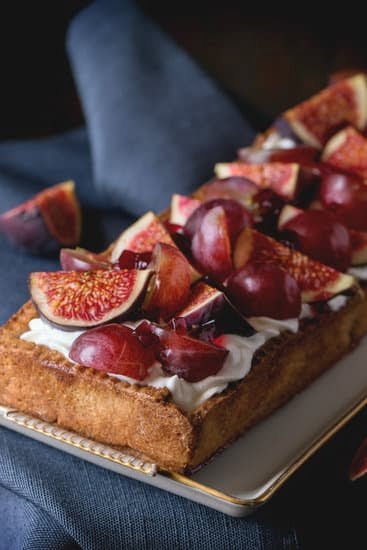Decorating cake with fruit adds a fresh and vibrant touch to any baked creation. Not only does it enhance the visual appeal of the cake, but it also brings a natural sweetness and burst of flavors that complement the overall taste. Whether you’re looking to impress your guests or simply want to indulge in a healthier dessert option, decorating cakes with fruit is a perfect choice.
There are several benefits to using fruit as a decoration on cakes. Firstly, fruits like berries, citrus slices, and tropical fruits add stunning colors and textures that can elevate the aesthetic appeal of any cake. Secondly, they provide a contrast to the richness of the cake itself, adding brightness and tanginess that cuts through the sweetness. Additionally, fruits contain vitamins, antioxidants, and dietary fibers, making them a healthier alternative compared to traditional sugary decorations.
When it comes to choosing the right fruits for cake decoration, considering seasonality is crucial. Fresh seasonal fruits not only taste better but also tend to be more affordable and readily available. Furthermore, pairing complementary flavors is essential for creating harmonious taste combinations. For example, citrus fruits pair well with vanilla or chocolate-flavored cakes while berries go perfectly with lemon or cream-based cakes.
In the following sections of this article, we will delve deeper into various aspects of decorating cakes with fruit. We will discuss tips and techniques for preparing and arranging fruits on cakes as well as different styles such as using fresh, frozen, dried, or candied fruits.
Additionally, we will explore specific types of cakes that can be adorned with fruit decorations and provide design ideas for creating beautiful patterns or arrangements. So let’s dive in and discover how fruit can transform ordinary cakes into extraordinary creations.
The Top Benefits of Decorating Cakes with Fruit
Decorating a cake with fruit can add not only beauty but also flavor to your creations. Whether you’re a professional baker or simply enjoy making cakes for special occasions, incorporating fruit into your decorations can elevate your cake to the next level. In this section, we will explore the top benefits of decorating cakes with fruit.
Firstly, using fruit as a decoration provides a fresh and vibrant look to your cake. The natural colors of fruits such as strawberries, blueberries, kiwis, and oranges can instantly brighten up any cake. It gives a wonderful contrast against the smooth and creamy frosting and adds visual appeal to the overall presentation.
Secondly, decorating cakes with fruit not only enhances the appearance but also adds delicious flavors. Fruits can bring a burst of freshness and juiciness to each bite, complementing the sweetness of the cake and frosting. Whether you choose to use sliced fruit as a topping or incorporate pureed fruits into the batter or frosting, it adds an additional layer of taste that will impress your guests.
Lastly, decorating with fruit also offers health benefits. Fruits are packed with essential vitamins and minerals that are good for our bodies. By incorporating them into cake decorations, you are providing an opportunity for people to enjoy something sweet while still getting some nutritional value from the fruits.
| Benefits | Description |
|---|---|
| Fresh Look | Fruits provide natural colors that brighten up the cake and add visual appeal. |
| Delicious Flavor | Fruits bring freshness, juiciness, and a burst of flavor to each bite. |
| Health Benefits | Fruits offer essential vitamins and minerals while still indulging in something sweet. |
Choosing the Right Fruits for Cake Decoration
When it comes to decorating cakes with fruit, choosing the right fruits is crucial for both taste and visual appeal. One important factor to consider is the seasonality of the fruits. Using fresh fruits that are in season not only ensures that they are at their peak flavor but also adds a touch of freshness and vibrancy to your cake.
To determine which fruits are in season, it’s helpful to refer to a seasonal fruit chart or consult your local farmers’ market. For example, during the summer months, berries like strawberries, blueberries, and raspberries are abundant and bursting with sweetness. In contrast, during the fall and winter seasons, citrus fruits like oranges, lemons, and pomegranates add a bright and tangy twist to your cakes.
Pairing the right fruits together is another important consideration when decorating cakes. Combining complementary flavors can elevate your cake’s taste profile. For instance, pairing tart apples with sweet caramel or cinnamon-infused cream cheese frosting creates a perfect balance of flavors. Similarly, combining tropical fruits like mangoes and passion fruit can add a refreshing tropical twist to your cake.
| Fruit | Seasonality |
|---|---|
| Strawberries | Spring/Summer |
| Raspberries | Summer/Fall |
| Peaches | Summer |
| Pineapple | All year round |
| Pears | Fall/Winter |
| Oranges | Winter |
By considering the seasonality of fruits and their pairings, you can create beautiful and flavorful combinations that will enhance the overall appeal of your cake. So before you start decorating, make sure to identify which fruits are in season and experiment with different flavor combinations to find the perfect match for your cake.
Preparing and Arranging Fruit for Cake Decoration
Decorating a cake with fruit not only adds a burst of color and freshness, but it also creates an eye-catching and delicious presentation. However, it is crucial to prepare and arrange the fruit properly to ensure that they stay fresh, vibrant, and securely in place. Here are some tips and techniques for preparing and arranging fruit for cake decoration:
- Wash and dry the fruit: Before using any fruit for garnishing your cake, make sure to wash them thoroughly under cold running water to remove any dirt or residue. After washing, gently pat them dry with a clean towel or paper towels.
- Slice and chop evenly: It is important to slice or chop the fruits into uniform sizes to achieve a visually appealing arrangement on the cake. Use a sharp knife or kitchen mandoline slicer to ensure consistent thickness.
- Remove excess moisture: Some fruits tend to release excess moisture, which can make your cake soggy. To prevent this, place sliced fruits on paper towels for a few minutes before using them as decorations.
- Create a stable base: To secure the fruits onto the cake surface firmly, use a thin layer of frosting or ganache as an adhesive between the fruit slices and the cake.
- Consider color coordination: Experiment with different colors of fruits that complement each other or contrast with the cake’s color for an aesthetically pleasing result. For example, vibrant berries can add pops of reds or blues on a white frosted cake.
- Arrange strategically: Start from the center of the cake and work your way outwards when placing the fruit slices or pieces on top. Ensure that there is enough space between each piece so that they don’t overcrowd each other.
- 7.Mind seasonality and pairings: Opt for seasonal fruits as they are likely to be fresher, juicier, and more flavorful. Additionally, consider pairing fruits that blend well together in terms of taste profiles – for example, strawberries and kiwis or peaches and blueberries.
- Explore different designs: Get creative with your fruit arrangements by trying out various designs such as concentric circles, diagonal lines, or geometric patterns. You can also go for a more organic and rustic look by scattering fruits randomly on top of the cake.
By following these tips and techniques, you can achieve visually stunning cake decorations that are both delicious to eat and pleasing to the eye. Remember to consider the seasonality of the fruit, pay attention to how they pair together in terms of taste, and experiment with different arrangements and designs to elevate your cake decorating skills even further.
Different Fruit Decorating Styles
When it comes to decorating cakes with fruit, there are various styles that you can choose from to achieve the perfect look for your cake. Whether you prefer the freshness of fresh fruit, the vibrant colors of frozen fruit, the unique texture of dried fruit, or the sweetness of candied fruit, each style offers its own distinct benefits and appeal.
- Fresh Fruit: One of the most popular and classic ways to decorate a cake with fruit is by using fresh fruits. Fresh fruits not only add a burst of color and natural beauty to your cake but also bring a refreshing taste and texture.
Some commonly used fresh fruits for cake decoration include berries (such as strawberries, raspberries, and blueberries), sliced kiwi, thinly sliced oranges or lemons, and edible flowers. You can arrange these fruits in various patterns like concentric circles or diagonal lines to create an eye-catching design. - Frozen Fruit: Frozen fruits can be a great option for decorating cakes as they have a longer shelf life compared to fresh fruit while still maintaining their natural flavors and colors. Not only do they add a pop of vibrant color to your cake, but they also help keep the cake cool during warmer weather.
Popular frozen fruits for cake decoration include frozen berries like raspberries or mixed berries, which can be arranged in a similar way as fresh berries on top of the cake. - Dried Fruit: If you’re looking to add unique textures and flavors to your cake decoration, dried fruits are a wonderful option. Dried fruit can be either purchased commercially or made at home by dehydrating your favorite fruits. They provide an interesting chewiness that contrasts well with soft frosting or sponge cakes. Some popular dried fruits that work well for cake decoration include apricots, figs, cherries, or cranberries.
- Candied Fruit: Candied fruit adds a touch of sweetness and elegance to any cake decoration. The process involves cooking fruit in a sugar syrup until they are coated and preserved. Candied fruits can be used as a topping, arranged in beautiful patterns, or even incorporated into the cake batter itself. Common examples of candied fruit include cherries, citrus peel, or pineapple.
Overall, the choice of fruit decorating style depends on personal preference and the specific look you’re trying to achieve for your cake. Whether it’s the freshness of fresh fruit, vibrant colors of frozen fruit, unique texture of dried fruit, or sweetness of candied fruit, each style brings its own charm to elevate your cake decoration. Experimenting with different styles can lead to stunning results that will impress anyone who sees and tastes your beautifully decorated cake.
Decorating Specific Types of Cakes with Fruit
Layer cakes, bundt cakes, and cupcakes are all popular choices for cake lovers, and decorating them with fruit can truly elevate their appearance and flavor. Each type of cake provides different opportunities for showcasing fruit as a decoration, and there are various techniques you can employ to achieve stunning results.
Layer cakes offer multiple tiers, providing ample space to showcase a variety of fruits in different arrangements. One popular option is to create a fruit filling between the layers of cake. This not only adds visual appeal but also adds a burst of fruity flavor with every bite. Additionally, layer cakes can be adorned with fresh fruit on top or around the sides, creating an eye-catching display.
Bundt cakes have a distinctive shape thanks to their central hole or “tube.” This opening can be filled with delicious fruits like berries or citrus slices for a vibrant pop of color. Alternatively, you can arrange sliced fruits on top of the cake or around the central hole for an elegant presentation. Bundt cakes are often served plain or with a light glaze, allowing the fruit decoration to take center stage.
Cupcakes are perfect for individual servings and lend themselves well to intricate fruit designs. One simple yet impactful way to decorate cupcakes is by placing a small slice of fruit on top of each one. Berries such as raspberries or blueberries work particularly well due to their size and vibrant colors. You can also create more elaborate designs by arranging multiple slices or pieces of fruit to form patterns or even edible portraits.
| Type of Cake | Fruit Decoration Ideas |
|---|---|
| Layer Cakes | Create a fruit filling between layers; adorn with fresh fruit on top or around sides |
| Bundt Cakes | Fill the central hole with fruits; arrange sliced fruits on top or around the hole |
| Cupcakes | Place a small slice of fruit on top; create elaborate designs by arranging multiple fruit pieces |
Fruit Design Ideas
When it comes to decorating cakes with fruit, there are endless possibilities for creating beautiful patterns and arrangements. Whether you want to add a touch of elegance to a wedding cake or make a whimsical birthday cake, fruit can be the perfect addition. Here are some fruit design ideas that will help you create stunning cake decorations:
- Fruit Flower Bouquet: Create a floral arrangement using various fruits such as strawberries, blueberries, kiwi slices, and orange segments. Arrange the fruits in the shape of flowers, adding leaves made from green grapes or mint leaves. This design is perfect for spring and summer-themed cakes.
- Fruit Mosaic: Take small pieces of different fruits like mangoes, pineapples, raspberries, and blackberries and arrange them into a mosaic pattern on top of the cake. This design adds a burst of color and texture to any cake.
- Gradient Fruit Cascade: For an eye-catching effect, arrange fruits in a gradient color scheme from top to bottom or vice versa. Start with one type of fruit at the top in its original color (such as cherries), then gradually transition to another type of fruit with a slightly different shade (such as raspberries), until you reach the bottom where the colors are fully blended (such as strawberries).
- Geometric Fruit Shapes: Cut various fruits into uniform shapes such as cubes, triangles, or circles and arrange them in neat geometric patterns on your cake. This style works well for modern or minimalist designs.
Remember, when creating patterns and arrangements with fruit on cakes, it’s important to consider the overall theme and aesthetic you’re going for. Consider using contrasting colors for bold statements or complementary colors for an elegant look.
In addition to these ideas, don’t shy away from experimenting with your own unique designs by combining different techniques or incorporating other elements like edible flowers or herbs. Fruit decorations can truly elevate the visual appeal of any cake and make it a centerpiece at any event or celebration.
Fruit-Flavored Cake and Frosting
Incorporating fruit into every layer of a cake adds an extra burst of flavor and a touch of freshness to each bite. Fruit-flavored cakes have become increasingly popular as people seek out unique and inventive flavors for their desserts. By using fresh or even pureed fruit, you can infuse your cake batter and frosting with natural sweetness and tanginess that complements the overall flavor profile of the dessert.
Choosing the Right Fruits for Flavorful Cakes
When it comes to choosing fruits for your cake, it’s important to consider their texture, moisture content, and flavor intensity. Some fruits lend themselves better to baking as they remain firm and hold their shape while others are softer and juicier when ripe. Berries such as strawberries, raspberries, and blueberries work well in cakes as they add a burst of color and juicy sweetness.
Citrus fruits like lemons, oranges, or limes enhance the flavors with their tangy notes. Tropical fruits such as pineapple or mango can also bring a delightful tropical twist to your cake.
Infusing Fruit into Cake Batter
To incorporate fruit into your cake batter, you can start by pureeing or finely chopping the fruit and adding it directly to the batter during preparation. This will distribute the fruit evenly throughout the cake, adding moisture and flavor to each slice. You may also consider using fruit juice in place of some of the liquid called for in the recipe for an extra fruity kick.
Another way to incorporate fruit is by folding small pieces or chunks into the batter just before baking. This provides pockets of concentrated fruity goodness in each bite.
Fruit-Flavored Frosting Options
To continue the fruity theme throughout your cake, consider making a fruit-flavored frosting as well. You can achieve this by simply adding pureed or mashed fruit into your favorite buttercream or cream cheese frosting recipe. Not only will it add natural sweetness and flavor, but it will also give your frosting a beautiful color.
For a lighter option, you can whip cream or mascarpone cheese with fruit puree to create a luscious and creamy fruit-flavored frosting. This type of frosting works particularly well for layer cakes and can be used as both filling and frosting.
Special Occasions and Celebration Cakes
Weddings, birthdays, and anniversaries are all special occasions that call for a beautiful and delicious cake. Adding fruit decorations to these celebration cakes not only enhances their visual appeal but also adds a fresh and vibrant flavor profile. Whether you are a professional baker or simply someone who loves to bake for special occasions, incorporating fruit into your cake designs can create stunning and memorable desserts that will impress your guests.
Weddings
When it comes to weddings, fruit decorations on cakes can bring a touch of elegance and sophistication. One popular choice is to create cascading fruit arrangements on tiered wedding cakes. Fresh berries like strawberries and raspberries work well in this design, along with delicate fruits like grapes or cherries. These arrangements can be placed between each tier or gracefully flowing down the sides of the cake.
Another popular option for wedding cakes is to incorporate edible flowers and citrus fruits into the design. Citrus fruits such as lemons or oranges can add a refreshing flavor to the cake, while edible flowers like pansies or violets create a romantic aesthetic. These fruit decorations can be used as accents throughout the cake layers or as a garnish on top of the frosting.
Birthdays
For birthday cakes, fruit decorations provide an opportunity to personalize the design based on the recipient’s preferences. Consider using their favorite fruits to create unique patterns and arrangements on the cake surface. For example, if they love tropical fruits, you could use pineapple slices, kiwis, mangoes, or passion fruits as decorative elements. Or if they have a favorite berry, such as blueberries or blackberries, you could incorporate them into both the filling and decoration of the cake.
A fun idea for children’s birthday cakes is to create playful shapes using sliced fruits like strawberries or watermelon cutouts. You could arrange them in whimsical patterns such as hearts, stars, or even their initials. This not only adds a fresh and healthy element to the cake but also makes it visually appealing for young ones.
Anniversaries
When it comes to anniversary cakes, consider the couple’s preferences and the milestone they are celebrating. For instance, for a romantic or elegant celebration, opt for red fruits like strawberries or raspberries to create heart-shaped designs on the cake. You could also use edible gold leaf or chocolate-covered strawberries to add a luxurious touch.
For couples who prefer a more rustic or nature-inspired theme, choose fruits that complement each other in terms of color and flavor. For example, you could combine peaches and blueberries or pears and cranberries in an autumn-inspired design.
Overall, when decorating cakes with fruit for special occasions and celebrations, it’s important to consider the theme, colors, flavors, and personal preferences of the event. Fruit decorations provide endless possibilities for creativity and customization to make each cake as unique as the occasion it celebrates.
Final Tips and Tricks for Decorating Cakes with Fruit
Longevity of Fruit Decorations
When decorating cakes with fruit, it is important to consider the longevity of the decorations. Fresh fruit has a limited shelf life and can start to wilt or spoil after a few hours at room temperature. To ensure that your fruit decorations stay fresh for as long as possible, it is best to add them to the cake just before serving. This will help maintain their vibrant colors and crisp textures.
If you need to decorate the cake in advance, there are a few strategies you can employ to prolong the freshness of the fruit. Firstly, choose fruits that are known for their long shelf life, such as berries, grapes, and citrus fruits. These fruits tend to hold up better than delicate ones like raspberries or peaches.
Another tip is to lightly brush the fruit with lemon juice or a thin layer of clear gelatin before placing them on the cake. The acidity in lemon juice helps keep the fruit from oxidizing and browning, while gelatin creates a protective barrier that helps preserve their appearance.
Storage and Handling
Proper storage and handling techniques are crucial when working with fruit for cake decoration. Before using the fruit, wash it thoroughly under running water to remove any dirt or pesticides. Pat dry gently with paper towels or allow them to air dry completely before placing them on the cake.
When storing decorated cakes with fruit in the refrigerator, cover them loosely with plastic wrap or place them inside a cake carrier. This will protect against moisture loss and prevent the fruit from absorbing unwanted flavors from other foods in the fridge.
It’s important to note that some fruits should not be stored together due to their gas production levels. For example, apples emit ethylene gas which can cause other fruits nearby to ripen more quickly. To avoid this issue, store apples separately from other types of fruits when decorating cakes.
Presentation Techniques
The presentation of fruit on the cake can greatly impact its overall appearance. One technique to elevate the visual appeal is by adding a shiny glaze to the fruit. To create a glaze, simply heat together equal parts of apricot jam and water. Brush this mixture gently over the fruit, and it will give them a glossy finish.
Another way to enhance the presentation is by strategically placing fruits in different sizes and shapes. Arrange larger fruits, such as strawberries or orange slices, towards the edge of the cake for an eye-catching effect. Fill in any gaps with smaller fruits like blueberries or raspberries.
Lastly, consider adding some greenery to your fruit decorations. Dainty mint leaves or fresh basil leaves can provide a pop of color and add an extra element of freshness to the cake. Place these leaves strategically between or around the fruit to create a beautiful and visually appealing design.
By following these final tips and tricks for decorating cakes with fruit, you’ll be able to create stunning and delicious treats that are sure to impress any guest or loved one. Whether it’s for a special occasion or just because, incorporating fruit into your cake decorations adds natural beauty and vibrant flavors that everyone can enjoy.
Conclusion
In conclusion, decorating cakes with fruit is a fantastic way to elevate your cake decorating skills. Not only does it add a pop of color and freshness to your creations, but it also brings a delightful burst of flavor to each bite. By choosing the right fruits for cake decoration based on seasonality and pairings, you can ensure that your cakes are not only visually appealing but also taste amazing.
Preparing and arranging fruit for cake decoration requires some tips and techniques to ensure that the fruits stay fresh and vibrant. Whether you choose to use fresh, frozen, dried, or candied fruit, each style offers its own unique texture and taste. Experimenting with different fruit decorating styles allows you to unleash your creativity and create stunning designs on your cakes.
When it comes to decorating specific types of cakes with fruit, such as layer cakes, bundt cakes, or cupcakes, the possibilities are endless. Consider the theme or occasion for which you are making the cake and let your imagination run wild. Fruit design ideas offer countless opportunities for creating beautiful patterns and arrangements that will impress both visually and in terms of taste.
Incorporating fruit into every layer of the cake by using fruit-flavored cake batter and frosting takes the flavor profile to another level. The infusion of fruity goodness throughout adds complexity to each bite while still maintaining the essence of a traditional cake.
For special occasions like weddings, birthdays, or anniversaries, there are numerous fruit decoration ideas that can make your cake stand out as a centerpiece. From cascading berries on a wedding cake to intricate designs for milestone birthdays, adding fruit as a decoration brings an element of sophistication and elegance.
Lastly, in order to make sure your carefully decorated cake stays beautiful until it’s time to serve, understanding longevity techniques along with proper storage is essential. Additionally, presentation techniques such as using edible flowers or chocolate garnishes can take your fruity decorations to another level.
Frequently Asked Questions
How do you decorate a cake with fresh fruit?
Decorating a cake with fresh fruit is a delightful way to add color, freshness, and a burst of flavor to your creation. To start, ensure that your cake is completely cooled before beginning the decoration process. Next, choose an assortment of fruits that are both visually appealing and complementary in taste. It’s best to use firm fruits that won’t easily wilt or release excessive moisture onto the cake.
Wash and dry each piece of fruit thoroughly before placing them on the cake. Depending on the design you have in mind, you can arrange the fruit slices in various patterns like concentric circles, diagonals, or even create intricate designs such as flower petals or leaves. Take care not to overcrowd the cake with too much fruit, as it may become overwhelming visually and affect the overall texture of the dessert. Lastly, if desired, you can brush a thin layer of apricot glaze or light syrup over the fruit to enhance its appearance and prevent browning.
How far in advance can I put fresh fruit on a cake?
When it comes to placing fresh fruit on a cake in advance, timing is crucial to maintain optimal freshness and prevent any detrimental effects on both taste and appearance. Generally, it is recommended to put fresh fruit on a cake no more than 4-6 hours prior to serving. Any longer than this duration can compromise the texture and juiciness of the fruits due to their natural enzymatic activity.
Chilled fruits tend to release less moisture onto the cake compared to those at room temperature while still maintaining their refreshing nature. Therefore, if necessary or for added convenience, you can refrigerate the decorated cake until it’s ready for presentation but ensure that it’s stored separately from other strongly odored items since some fruits might absorb surrounding smells.
Which fruit is used to decorate cakes?
When it comes to decorating cakes with fruit, there are several options available depending on personal preferences and what pairs well with your chosen cake flavors. Some commonly used fruits for decorating cakes include berries such as strawberries, raspberries, blueberries, and blackberries. They not only provide vibrant pops of color but also offer a delightful sweetness that complements most cakes. Other popular choices include sliced kiwi, peaches, nectarines, or citrus fruits like orange or lemon slices.
These fruits bring a zesty tang and aesthetic appeal to your cake designs. Additionally, tropical fruits like pineapple chunks or mango slices can contribute a tropical flair and unique texture to the overall presentation. Ultimately, the choice of fruit is entirely flexible and depends on your creativity and the flavors you wish to combine to create an enticing and visually stunning cake decoration.

Welcome to our cake decorating blog! My name is Destiny Flores, and I am the proud owner of a cake decorating business named Cake Karma. Our mission is to provide delicious, beautiful cakes for all occasions. We specialize in creating custom cakes that are tailored specifically to each customer’s individual needs and tastes.





